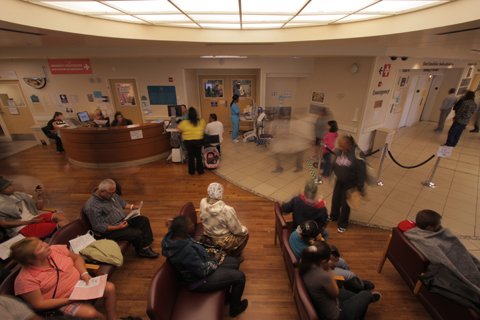
WHAT'S WRONG WITH THIS PICTURE? Just about everything. |
Toward the end of 2012, the US Census Bureau reported that for the first time in years, the number of uninsured Americans had actually fallen — to 48.6 million, from an all-time high of 49.9 million in 2010. The upsurge in insurance coverage was attributed to an increase in the number of people with government health insurance (such as Medicare or Medicaid), as well as an Affordable Care Act provision allowing young adults to stay on their parents' plan until age 26.
A report issued just last month by a New York-based research foundation indicated that 39 states have yet to implement any laws or regulations that would enable them to enforce many of the Affordable Care Act's major health reforms, including bans on denying people health insurance based on pre-existing conditions and limits on out-of-pocket costs. (Maine is one of the 11 states that actually has taken some action.)
We could go on — for pages, for hours — detailing the intricacies of health-care policy. But let's be honest: the statistics start to swim when you look at them too long. Dry facts and numbers are ineffective at illustrating the utter dysfunction of the United States health-care system and the very concrete ways in which that system fails American citizens. For that, we turn to The Waiting Room, a 2012 documentary directed by award-winning filmmaker Peter Nicks, which offers an engaging glimpse beyond the swinging hospital doors.
Zeroing in on a few core characters (patients and medical professionals alike), The Waiting Room shows 24 hours in a bustling California emergency room, condensed into less than two. The tagline is "24 hours, 241 patients, One stretched ER," but to say that Highland Hospital in Oakland, California, is "stretched" seems a major understatement. The place is bursting; doctors, nurses, and medical assistants are forced to play Tetris with hospital beds and patients in a desperate attempt to treat hundreds of vastly different complaints.
Tender and unobtrusive, the camera follows a young girl with a terrible case of strep throat, her tonsils so swollen she is barely able to speak or even smile. She doesn't have a regular doctor; her terrified parents don't have health insurance.
We meet a "regular," addicted to drugs and drink, who has been to the ER dozens of times in one year and whose halfway house is refusing to take him back. Rather than discharge him onto the street, the doctor decides to admit the patient to the hospital, acknowledging that sometimes he feels obligated to admit people for social reasons as well as medical ones.
There's a hippie with a testicular tumor, several patients who come in needing medication refills or dialysis treatments, and acute trauma victims with gunshot wounds. Almost everyone is unable to pay, and flabbergasted by the cost, in many cases having put off treatment because they were scared of the forthcoming bill. Nicks zooms in on worry lines and pained grimaces, granted incredible access at people's most vulnerable moments.
Despite the fact that, as one doctor puts it, "the ER is not the place to manage someone's overall health," many uninsured Americans use it as such. The Waiting Room is a respectful, yet insistent, reminder of the ER's safety-net function, which is often cited as a reason for health-care reform. There are better ways to serve people, more effective ways to help people, and less terrifying ways to treat the sick. The Waiting Room prods us to find them, and quickly.
BEYOND THE WAITING ROOM | directed by Peter Nicks | 81 minutes | at SPACE Gallery, 538 Congress St, Portland | February 13 @ 7:30 pm | $7 | space538.org